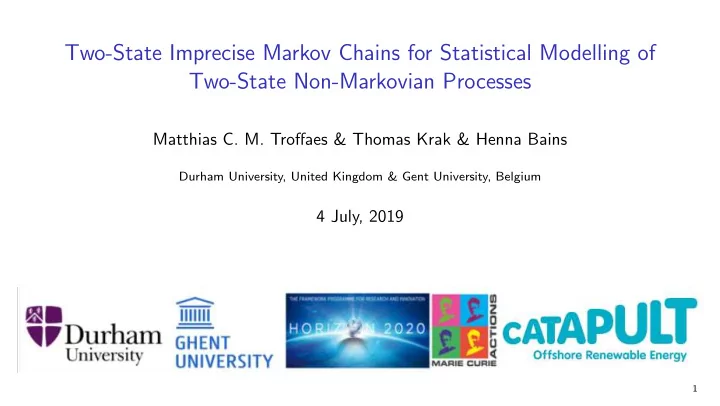

Two-State Imprecise Markov Chains for Statistical Modelling of Two-State Non-Markovian Processes Matthias C. M. Troffaes & Thomas Krak & Henna Bains Durham University, United Kingdom & Gent University, Belgium 4 July, 2019 1
Aim present a new framework for ◮ fitting an imprecise two-state Markov chain ◮ to data generated by a two-state non-Markovian process ◮ via an imprecise version of MCMC 2
The Old Way 1. transition times T i ∼ Exp ( λ i ) (i.e. precise Markov chain assumed) 2. set of priors for λ i 3. combine with data to get set of posteriors for λ i 4. posterior predictive bounds on λ i 5. use these bounds to fix an imprecise Markov chain what is wrong with this approach? 3
The Old Way what is wrong with this approach? ◮ model = set of distributions on parameters of a precise Markov chain imprecise Markov chains are not equivalent to this model ◮ sampling uncertainty ignored: only posterior predictive bounds are used no full uncertainty quantification ◮ imprecision does not reflect violations of stationarity & Markovianity wasted opportunity ◮ non-Bayesian analysis: inferences are not coherent with the model 4
The Newly Proposed Way 1. transition times T i ∼ f i ( λ i ) where f i is a non-Markovian and/or non-stationary process and λ i are unknown parameters of this process 2. set of prior distributions on λ i 3. for each prior, use standard MCMC to sample posterior realizations of λ i i.e. fit the non-Markovian process to the data 4. for each posterior sample of λ i bound process by an imprecise Markov chain 5. produce sample of posterior bounds for any predictive quantity 5
The Newly Proposed Way Nice features of this new approach: ◮ a form of imprecise MCMC: imprecision built into the predictive part this works because of Walley’s marginal extension theorem ◮ fully coherent robust Bayesian approach: predictions are directly derived from posterior distribution ◮ imprecision reflects lack of data & non-Markovianity & non-stationarity (even if there is lot’s of data, inferences can remain imprecise) 6
How Did We Do It ◮ non-Markovian behaviour modelled by a multi-state Markov chain can model any phase-type distribution for transition times! (every distribution can be approximated by a phase-type distribution) ◮ bounding by lumping multi-state Markov chains into imprecise two-state Markov chains ◮ details: see poster 7
Conclusions ◮ we’ve improved the way imprecise Markov chains are fitted ◮ imprecision results not only from limited data but also from characteristics of the process ◮ principles may apply to fitting of general stochastic processes (not only imprecise Markov chains) ◮ we identified a class of problems where imprecise MCMC is easy ◮ larger problems may require imprecise ABC if likelihood of phase-type distribution has no closed form 8
Thank You For Your Attention We look forward to see you at our poster! 9
References I [1] Bob Carpenter, Andrew Gelman, Matthew Hoffman, Daniel Lee, Ben Goodrich, Michael Betancourt, Marcus Brubaker, Jiqiang Guo, Peter Li, and Allen Riddell. Stan: A probabilistic programming language. Journal of Statistical Software , 76(1):1–32, 2017. [2] Gert de Cooman, Filip Hermans, and Erik Quaeghebeur. Imprecise Markov chains and their limit behavior. Probability in the Engineering and Informational Sciences , 23(4):597–635, October 2009. [3] Alexander Erreygers and Jasper De Bock. Imprecise continuous-time Markov chains: Efficient computational methods with guaranteed error bounds. In Alessandro Antonucci, Giorgio Corani, In´ es Couso, and S´ ebastien Destercke, editors, Proceedings of the Tenth International Symposium on Imprecise Probability: Theories and Applications , volume 62 of Proceedings of Machine Learning Research , pages 145–156. PMLR, Jul 2017. [4] Alexander Erreygers and Jasper De Bock. Computing inferences for large-scale continuous-time Markov chains by combining lumping with imprecision. ıa ´ In S´ ebastien Destercke, Thierry Denoeux, Mar´ Angeles Gil, Przemyslaw Grzegorzewski, and Olgierd Hryniewicz, editors, Uncertainty Modelling in Data Science , pages 78–86. Springer International Publishing, 2019. 10
References II [5] Thomas Krak, Jasper De Bock, and Arno Siebes. Imprecise continuous-time Markov chains. International Journal of Approximate Reasoning , 88:452–528, 2017. [6] Thomas Krak, Alexander Erreygers, and Jasper De Bock. An imprecise probabilistic estimator for the transition rate matrix of a continuous-time markov chain. ıa ´ In S´ ebastien Destercke, Thierry Denoeux, Mar´ Angeles Gil, Przemyslaw Grzegorzewski, and Olgierd Hryniewicz, editors, Uncertainty Modelling in Data Science , pages 124–132, 2019. [7] Marcel F. Neuts. Matrix-geometric solutions in stochastic models: an algorithmic approach . Dover, 1981. [8] Lewis Paton, Matthias C. M. Troffaes, Nigel Boatman, Mohamud Hussein, and Andy Hart. Multinomial logistic regression on Markov chains for crop rotation modelling. In Anne Laurent, Oliver Strauss, Bernadette Bouchon-Meunier, and Ronald R. Yager, editors, Proceedings of the 15th International Conference IPMU 2014 (Information Processing and Management of Uncertainty in Knowledge-Based Systems, 15–19 July 2014, Montpellier, France) , volume 444 of Communications in Computer and Information Science , pages 476–485. Springer, 2014. 11
References III Matthias Troffaes, Jacob Gledhill, Damjan ˇ [9] Skulj, and Simon Blake. Using imprecise continuous time Markov chains for assessing the reliability of power networks with common cause failure and non-immediate repair. In Thomas Augustin, Serena Doria, Enrique Miranda, and Erik Quaeghebeur, editors, ISIPTA’15: Proceedings of the 9th International Symposium on Imprecise Probability: Theories and Applications , pages 287–294, Pescara, Italy, July 2015. ARACNE. [10] Matthias C. M. Troffaes and Simon Blake. A robust data driven approach to quantifying common-cause failure in power networks. In F. Cozman, T. Denœux, S. Destercke, and T. Seidenfeld, editors, ISIPTA’13: Proceedings of the Eighth International Symposium on Imprecise Probability: Theories and Applications , pages 311–317, Compi` egne, France, July 2013. SIPTA. 12
Recommend
More recommend